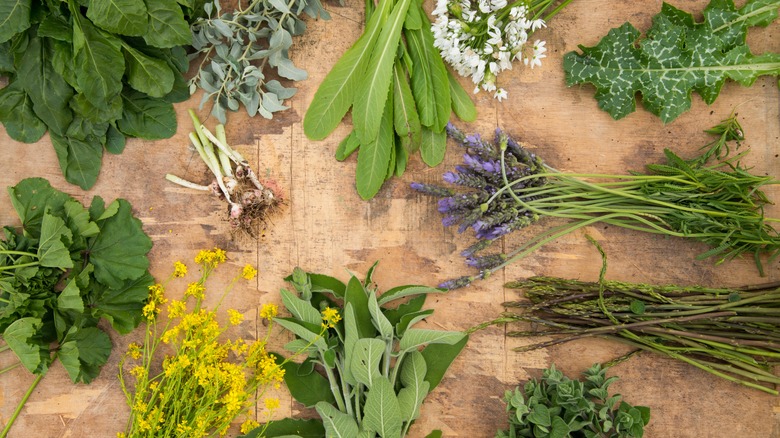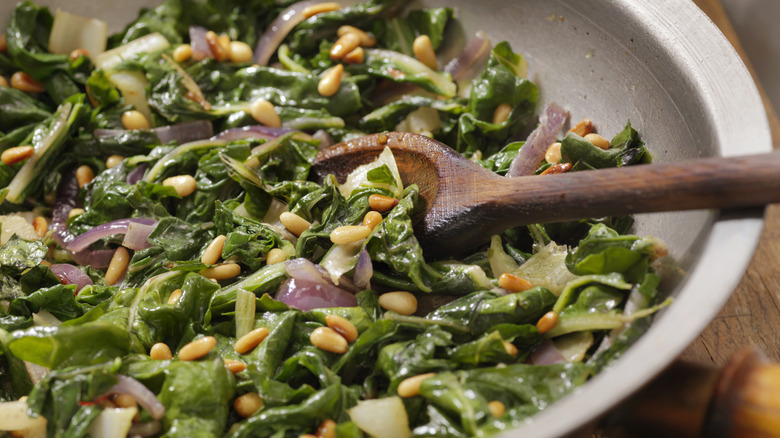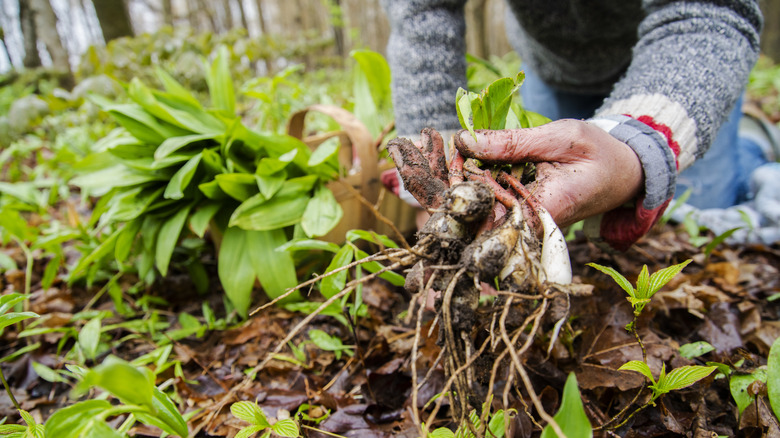Why Cooking Wild And Domestic Greens Together Is A Match Made In Heaven
Mother Nature provides an abundance of foods if you know where to look and how to safely harvest them. Wild greens are one such gift. If you've never investigated what they are and how they're used in the kitchen, you're missing out on a world of fresh flavors that can elevate just about any dish you make. While step one is locating these little gems, either at the grocery store or through foraging, deciding what to do with them once you get them home is an entirely different adventure.
The good news is that many common wild greens can be eaten fresh or cooked in the same way as the common domestic greens you're already familiar with. In fact, coupling wild and domestic greens together gives you the best of both worlds because it creates a balance of flavors — toning down the often bold taste of the wild options while elevating the comparatively banal and mild notes of the domestic ones.
There are likely countless wild greens readily available in your community. From sorrel and chickweed sold at the farmstand down the street to a hillside full of wild mustard and miner's lettuce, nature abounds. Even in your own backyard, dandelion and fiddlehead ferns can take a place on your plate. Edible natural greens vary in size, flavor, and texture, so they open the door to culinary creativity.
A harmonious flavor combination
While some wild greens, like dandelion, purslane, lamb's quarters, and garlic mustard, can be eaten raw, many others need to be blanched, soaked, or cooked through before consuming. Although delicious and nutritious, these same wild greens can produce a bitter dish. To counterbalance those stand-out flavors, sauté up your wild greens with some domestic spinach, or a little delight you may have never heard of called tatsoi, for a well-rounded dish. Whether you're whipping up the perfect omelet or exploring cultural roots through Ethiopian collard greens, mixing your leafy greens offers textural and nutritional variety.
Every edible plant is different. While flavors play a key role in a dish, it's not the only reason to mix it up between wild and domestic greens. Variety is the spice of life, so embrace a vast array of different plants and you'll find yourself experimenting with how the different textures work with certain dishes and play off of each other. When you do get the hang of it, don't hold back. The flavorful yet balanced combination of wild and domestic greens is amazing as a sautéed side dish, but they perform equally well in casseroles, soups, stir fry, pasta, and egg dishes. Try them in a pesto, too!
How to safely handle wild greens
Before you forage, educate yourself about the foods you're picking. Wild greens are a wonderful addition to any kitchen inventory, yet they can also be toxic if you choose the wrong plant. If you plan to pick wild greens yourself, download a reliable plant app, get some books, or go on an ethnobotany tour with a knowledgeable guide. Get a positive identification before picking and never remove more than 10% of the wild plants available so they can regenerate.
Whether you're harvesting stinging nettles, wild onions or chives, amaranth, chicory, violets, or cattails, you'll also need to know how to prepare them. Some plants can only be eaten if cooked. All parts are edible on certain species, while, for others, you may only be able to eat the leaves, roots, or flowers. Having said that, don't let it scare you away from trying new things.
Buy wild plants from a local vendor the first few times so you can become familiar with them before foraging your own. Also, incorporate wild greens a little at a time, both so you can become accustomed to the flavors and so you can find that heavenly balance between wild and domestic greens that will satisfy both your palate and your nutritionist.


